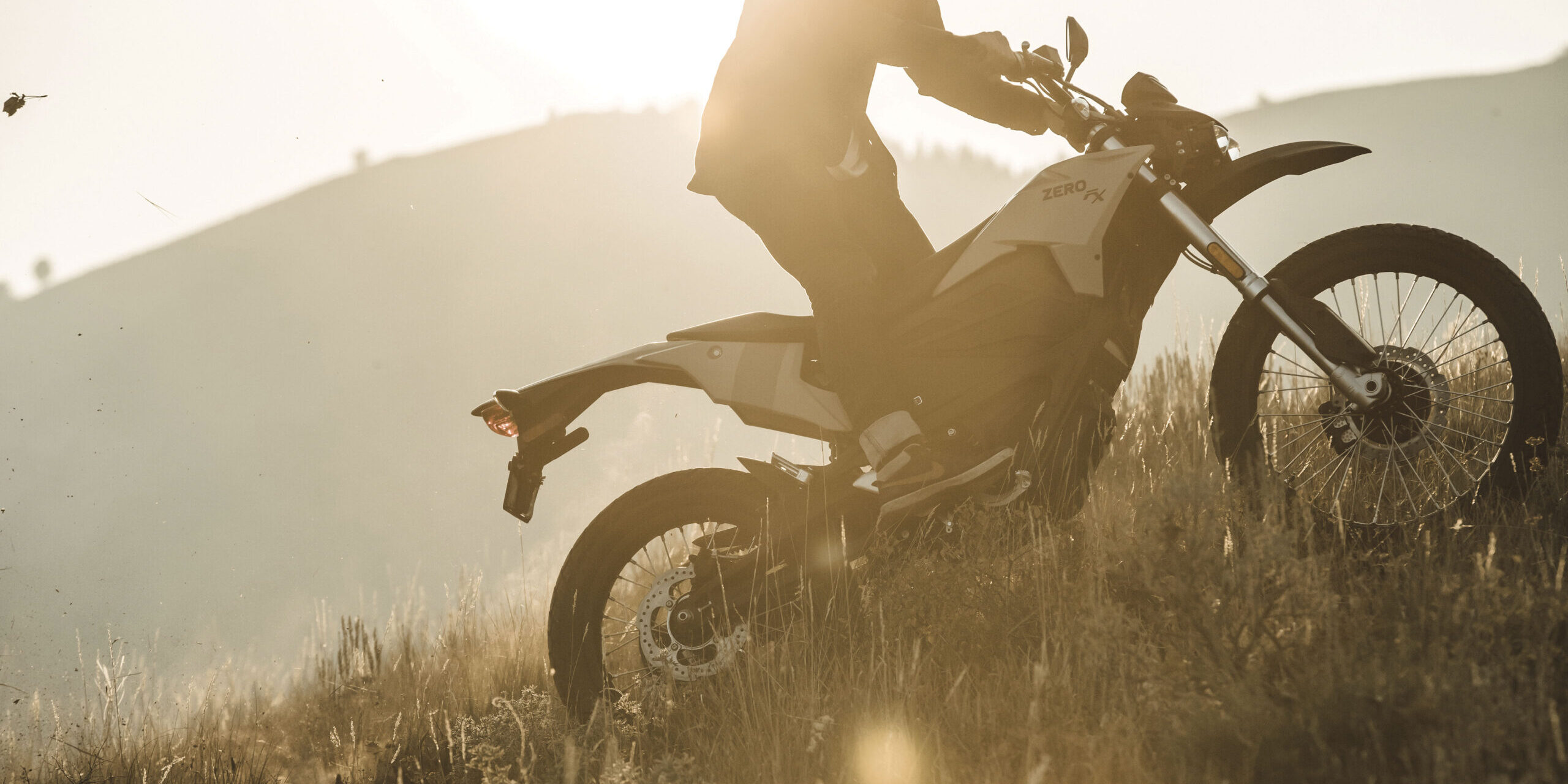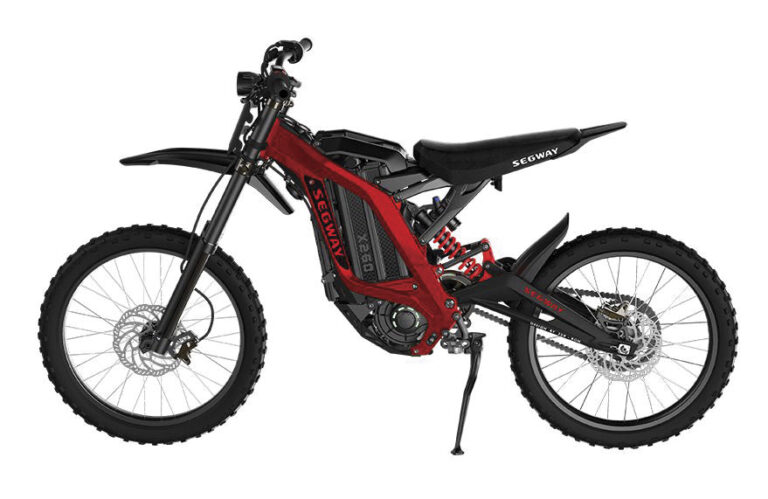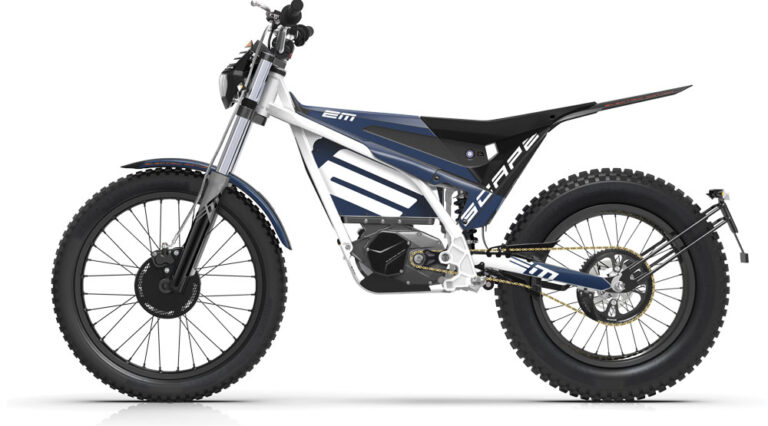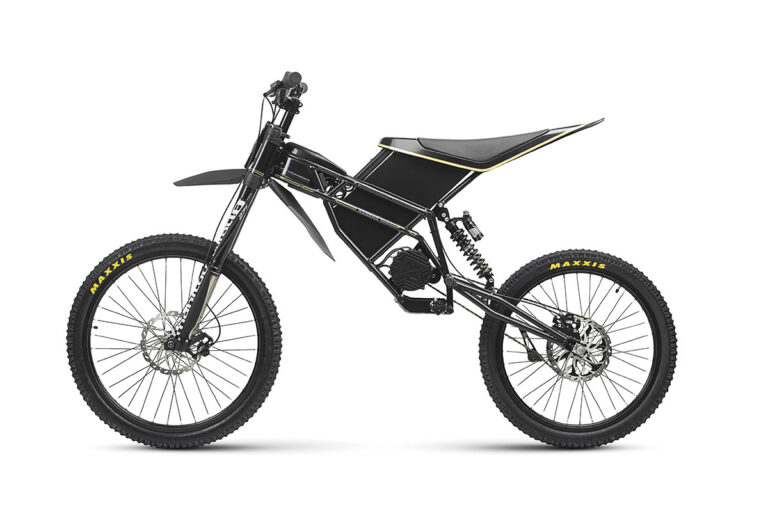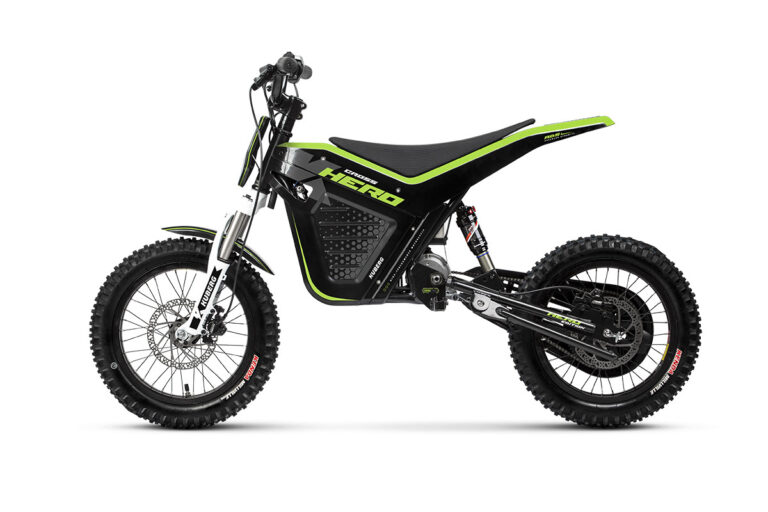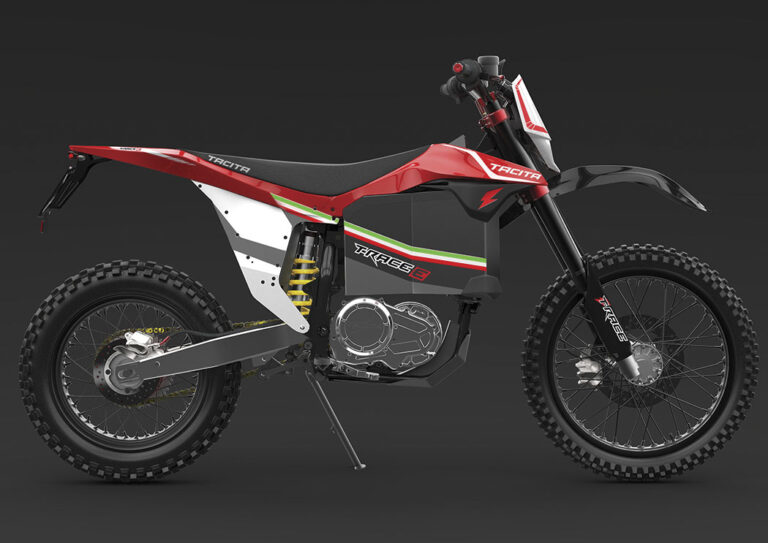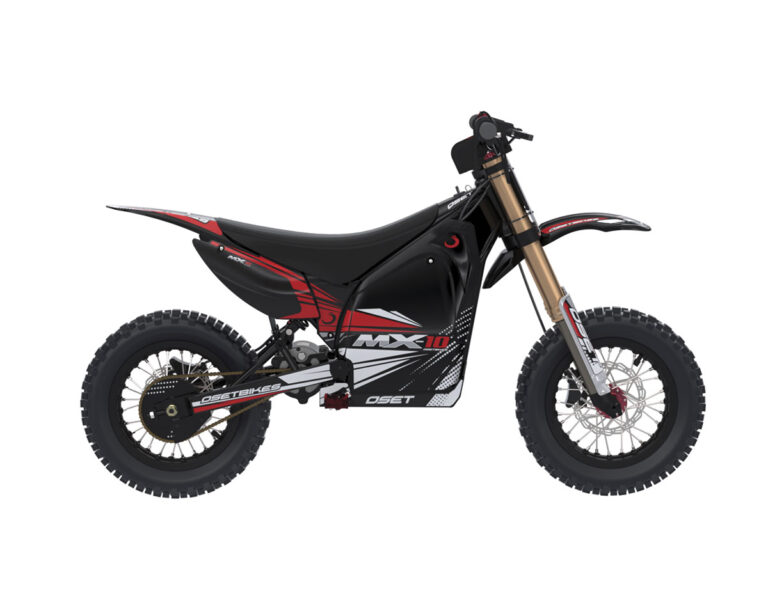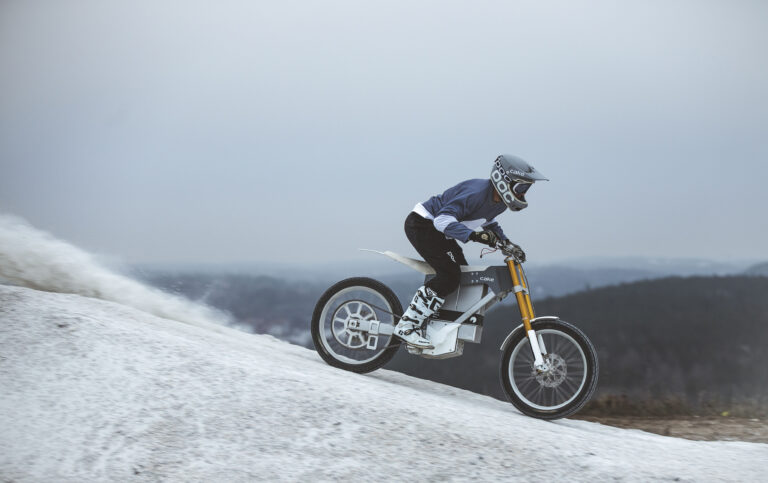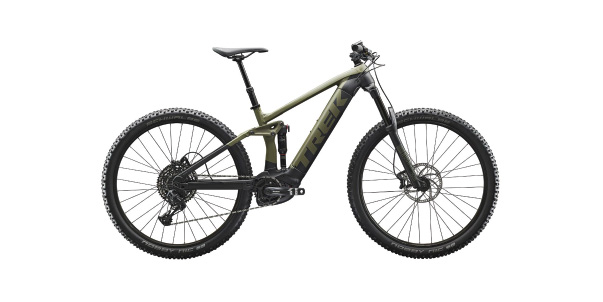AMERICAN MOTORCYCLIST June 2020
HIGH VOLTAGE ON THE TRAILS
Electric Motorcycles And Bicycles Are Changing Off-Road Riding

Electric dirt bikes are poised to revolutionize recreational riding, as well as dramatically change the public policy landscape of off-highway vehicle riding.
E-dirt bikes resolve two of the biggest objections from anti-OHV groups to motorcycles on public trails, and their easy tunability and low maintenance make getting into off-road riding much easier for many new riders. How quickly will the riding community trade gasoline for electrons and batteries?
Could electric dirt bikes spell the end of the trail for the internal combustion engine in off-road riding? Whatever the future holds, electric motorcycle technology is advancing rapidly and presents opportunities and challenges for OHV riders throughout the nation.
E Zero FX
Peak power: 20 kW
Charging time: 5.1 hours
Range: 46 miles city
Tires: 90/90 x 21 front,
120/80 x 18 rear
Seat height: 34.7 inches
Wheelbase: 56.6 inches
Weight: 247 pounds
MSRP: $8,995
Husqvarna EE 5
Peak power: 5 kW
Charging time: 1.2 hours
Range: 2 hours for a beginner,
25 minutes for a serious rider
Tires: 60/100 x 12 front, 2.75 x 10 rear
Seat height: 26.2 inches
Wheelbase: 40.6 inches
Weight: 89.3 pounds
MSRP: $5,149
KTM SX-E 5
Peak power: 5 kW
Charging time: 1.2 hours
Range: 2 hours for a beginner,
25 minutes for a fast junior racer
Tires: 60/100 x 12 front, 2.75 x 10 rear
Seat height: 27.5 inches
Wheelbase: 40.6 inches
Weight: 89.3 pounds
MSRP: $5,049
WHAT’S RIDING AN E-DIRTBIKE LIKE?
One rider who can answer from ample experience is AMA Charter Life Member and former AMA Board of Directors member Perry King. The well-known actor is a lifelong motorcyclist who worked with Zero Motorcycles Inc. on promotional videos.
King said most of the time he’s spent riding Zeros has been off-road on the company’s FX model.
He described the experience as “a magic carpet ride.”
Electric motors are known for delivering instant torque, and King said the Zeros he’s ridden offer a very different riding experience from the gasoline-powered dirt bikes he’s ridden.
“It’s like a [super] hooligan bike,” he said. “It feels like a small-block V8.”
One of the biggest benefits about electric motorcycles is the lack of carburetor or fuel mapping issues when riding in high-elevation terrain. Gas-powered dirt bikes may need to run different jets or fuel settings at higher elevations. But with electric motors, this problem is non-existent.
Two other important differences King said those new to electric motorcycles will notice are how quiet they are and little maintenance they require.
He described one experience where he was able to ride side-by-side with another rider on an electric dirt bike and carry on a conversation. He also said he gets a more pleasant reaction from the pedestrians he rides past on trails. He attributes that reaction to the low sound level, which doesn’t disturb the quiet many non-motorized trail users seek.
Cake Kalk OR
Peak power: 11 kW
Range: Up to three hour
Wheels: 24-inch front and rear
Seat height: 35.8 inches
Wheelbase: 51.6 inches
Weight: 152.1 pounds
MSRP: $13,000
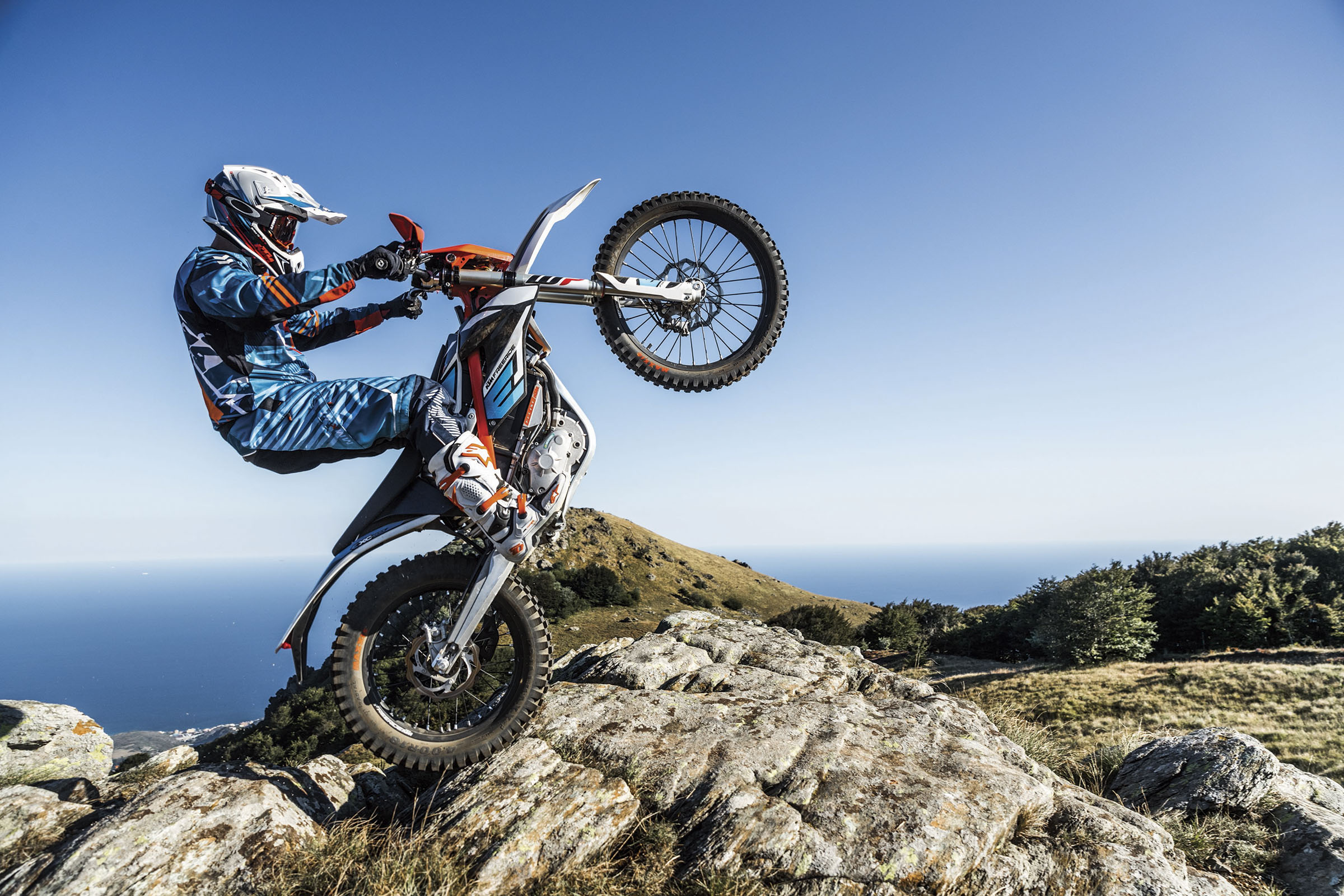
Segway Dirt eBike
Peak power: 5 kW
Charging time: 3-4 hours
Range: 74.6 miles
Tires: 70/100-19
front and rear
Seat height: 31.9 inches
Wheelbase: 49.8 inches
Weight: 121.3 pounds
MSRP: $4,499
When people hear the company name “Segway” they don’t think about dirt bikes. But Segway is now making one — the Segway Dirt eBike — in two flavors: the $4,499 X260 and the less powerful $2,999 X160. Segway says the Dirt eBike “is designed to be a hybrid between a mountain bike and dirtbike.”
The X260 offers 74.6 miles of fun before needing to be recharged, which takes up to four hours. But you can quickly swap out the battery if you’re in a hurry and then keep on riding. Weighing a light 121.3 pounds, the bike does zero-to 31 mph in 4.02 seconds.
The Segway Dirt eBike gives you three options to set top speeds, called the “novice,” “standard” and “sport” modes. The bike has an aluminum alloy frame, inverted front fork, and multi-link hydraulic spring rear shock. The Segway Dirt eBike looks like another bike from China, the Sur-Ron, since apparently
Maintenance
As for maintenance, most wear-and-tear on an electric dirt bike impacts the tires and brakes. These reduced costs save off-road riders a lot of time and money. It’s not necessary to rebuild your engine, replace clutch plates and more.
With the power an electric dirt bike can deliver, you may think they’re not for rookie trail riders.
King thinks the opposite. The Zeros he has ridden can be tuned using an app on a smartphone. So, if you’re new to off-road riding, you don’t need to buy a smaller bike. You can just dial back the power.
Another feature of electric bikes that King expects will help attract more riders is the lack of a clutch. Many new riders today don’t have experience driving manual-transmission cars, and the most difficult part of King’s experience instructing with car racing schools is teaching students how to use a clutch properly. A clutchless electric motorcycle removes one potential obstacle of mastering motorcycle riding.
Though an electric dirt bike’s power is easily tunable, new dirt bike riders should make sure they can get both feet flat on the ground when sitting astride an e-dirt bike before buying one.
The simple tuning and lack of a clutch also can help riders stay more focused on the riding experience.
King said one of his favorite things to do when setting up an electric dirt bike is to turn up the “regen” on the motor, which makes the battery recharging system act like a brake when he rolls off-throttle.
By eliminating the need to feather a clutch or apply the brakes as often, electric dirt bikes have allowed King to keep his focus on the trail ahead of him.
One of the downsides to owning an electric bike is the time it takes to recharge the battery. The process takes hours, and there are relatively few places to recharge an electric motorcycle along the nation’s highways, let alone along off-road trail systems.
King said the batteries on the electric dirt bikes he’s ridden have lasted for hours. And he says to not let the lack of recharging infrastructure dissuade you from giving it a try.
He compared the current situation to when the Ford Model T came out and the gas station network was not yet in place. Consumer demand for a refueling solution led to the proliferation of gas stations we have today. Something similar is likely on the horizon for electric motorcycles.
King said his enthusiasm for electric motorcycles hasn’t lessened his love of the internal-combustion engine.
“I still love gas-powered bikes, especially old Triumphs and Nortons,” he said. “But I love electric bikes as well.
They are the future.”
Electric Motion is a French company that has sold more than 1,500 electric motorcycles since its founding a decade ago. While the Electric Motion offers a variety of trials bikes, it also sells a light trailbike called the Etrek and an off-road bike called the Escape. The Escape has a 50.4- volt engine that powers the bike to a top speed of 43.5 mph. The steel-tube frame weighs less than 11 pounds. The lightweight (169.8 pounds) bike scoots through the woods for 38 miles before needing a recharge, with the recharge taking more than four hours.
The Escape features what the company calls a “Progressive Electronic Lever Switch” that electronically simulates a clutch, giving the rider better control of the bike’s power.
The bike also has what the company calls a Progressive Regenerative Brake that “enables the use of an electric and progressive brake, which charges the battery while in use. On top of that, this system brings a comfortable security on the hard slopes, while avoiding the brakes overheating.
Electric Motion Escape
Peak power: 11 kW
Charging time: 4.3 hours
Range: 37.9 miles
Rims: 1.6 x. 21 front,
2.15 x 18 rear
Seat height: 32.3 inches
Wheelbase: 52.2 inches
Weight: 169.8 pounds
MSRP: $8,500
Kuberg Freerider
Peak power: 8 kW
Charging time: 2.5 hours
Range: 1 hour
Tires: 20 x 2.5
front and rear
Seat height: 34.5 inches
Wheelbase: 48.5 inches
Weight: 79 pounds
MSRP: $4,999.99
Kuberg offers a variety of electric bikes from its teen- and adult-sized Freerider offroad machine to trials bikes to kid’s motocrossers for beginning riders and racers.
The Czech Republic company’s Cross Hero is for advanced riders ages 5 to 12. Kuberg says the little MXer’s 3 kW electric motor provides plenty of torque to get off the line in a race while adjustable air suspension provides for a smooth ride.
The bike comes with a speed limiter to help keep the child safe as well as hydraulic brakes. Plus, there are three power settings to control acceleration: “Beginner,” “Sports” and “Race.”
The Kuberg Volt App lets you connect the bike to your phone which allows you to set a boundary for where your child can ride, among other things. When the bike approaches the perimeter that you set the bike slows and you get an alert on your phone. The powder-coated tubular frame is steel.
While Kuberg mostly makes kids’ off-road machines, it also offers the Freerider for adults and teenagers.
The Czech Republic company gives riders the ability to customize their Freeriders with different motor and wheel sizes. The standard 8 kW motor has a top speed of 35 mph while the 12 kW gets up to 40 mph. The 14 kW motor tops out at 55 mph-plus.
The Freerider’s standard wheels are 20-inch front and rear shod with Maxxis Creepy Crawler performance tires. But 24/24 and 26/24 wheel sizes are also available. The bike features a clutchless one-speed transmission, steel double cradle tube frame, Manitou Dorado Expert front forks with 7 inches of travel, a DNM Burner RB-RCP rear shock and 203mm disc brakes. Kuberg also has what it calls the Kuberg Volt App that the company calls “an entire toolkit inside your pocket.” With the app, the owner can adjust speed and torque, use a phone as a speedometer, time laps and more.
Kuberg Cross Hero
Peak power: 3 kW
Charging time: 6 hours
Range: Two hour
Tires: 16 x 2.4
front and rear
Seat height: 25 inches
Wheelbase: 37 inches
Weight: 77 pounds
MSRP: $2,199.99
The Italian company Tacita produces several electric motorcycles, including the T-Race Enduro off-road machine.
Unlike many electric motorcycles, the T-Race Enduro offers a five-speed transmission with a hydraulic clutch and Brembo master cylinder.
The bike is available in different motor sizes with the standard motor having maximum power of 27 kW @ 8,000 rpm. The other sizes available are 11 kW and 34 kW. The bike has two power maps: “Eco” to maximize efficiency and traction, and “Power” for all-out riding.
The T-Race Enduro also allows the rider to use an engine brake when needed on demanding terrain such as steep downhills. Tacita also has an MXer in its stable.
Tacita T-Race Enduro
Peak power: 11 kW
Charging time: 2.5 hours
Range: Up to 3 hours
Wheels: 24-inch front and rear
Seat height: 35.8 inches
Wheelbase: 51.6 inches
Weight: 152.1 pounds
MSRP: $13,000
Vector Vortex
Peak power: 10 kW
Charging time: 2 hours
Range: 120 miles
Wheels: 2.75 x 18 front
3.5 x 17 rear
Seat height: 33.9 inches
Wheelbase: 51.2 inches
Weight: 130 pounds
MSRP: $5,999
Powered by a 10 kW electric motor, the Vector Vortex weighs just 130 pounds allowing for acceleration of zero-to-31 mph in under 3 seconds. Top speed? More than 50 mph.
Suspension in front is handled by a custom DNM USD8SA air fork with 7.9 inches of travel. The rear shock is a DNM Burner 2S with 8.7 inches of travel. Preload, rebound, and compression are adjustable at both ends. Braking chores are handled by two two-piston calipers and a couple 203mm rotors up front and a single four-piston caliper and 203mm disc in the rear.
Regenerative braking essentially uses the electric motor as a generator to produce energy. Vector says the rider can adjust the force of regenerative braking or even turn it off. Plus, the German company says: “Regenerative braking not only saves your brake pads but also returns up to 30 percent of energy back to (the) battery.” The frame and swingarm are steel.
The British company OSET makes electric trials bikes for kids and adults as well as a little motocrosser called the MX-10. The bike is for kids ages 4 to 7 and weighing up to 88 pounds. The OSET MX-10 sports a 48-volt motor that allows the machine to reach 22 mph.
Since it’s a beginner bike for small kids the bike’s power and speed are adjustable. The adjustments range from tame acceleration for beginners to quick acceleration for more experienced riders. Hydraulic brakes with 160mm rotors provide the stopping power and the brake levers are adjustable to better fit small hands.
Custom upside-down front forks and an adjustable oil shock in the rear handle suspension chores.
Oset MX-10
Peak power: 1.4 kW
Charging time: 5-6 hours
Range: 2-3 hours
Wheels: 10 x 1.6 front and rear
Seat height: Adjustable
(3 settings)
20.3 – 21.7 inches
Wheelbase: 37 inches
Weight: 81.99 pounds
MSRP: $3,199
Cake Kalk OR
Peak power: 11 kW
Charging time: 2.5 hours
Range: Up to three hours
Wheels: 24-inch front
and rear
Seat height: 35.8 inches
Wheelbase: 51.6 inches
Weight: 152.1 pounds
MSRP: $13,000
CAKE makes what it calls “Light Electric Off Road Motorbikes” and the CAKE Kalk OR is the first of its “performance, trail/enduro and free riding“ machines. CAKE is a Swedish electric bike company with a shipping warehouse in Salt Lake City. The company says the name Kalk “is derived directly from Kalksten, the limestone bedrock of the Swedish island of Gotland, where CAKE’s test grounds are located.”
The Kalk OR offers three riding modes that determine how long you can ride before you need to recharge: “Explore” limits speed to a more leisurely pace and extends the battery range to 3 hours, “Enduro” allows active trail riding for 1-to-2 hours and “Excel” is a race mode that cuts the riding time to an hour.
The top-shelf bits on the bike include Ohlins suspension. CAKE used its Kalk OR that’s priced at $13,000 as a jumping off point to build a lower-cost trailbike: the KALK INK ($9,500).
Electric dirt bikes aren’t simply changing the riding landscape of off-road recreation, they’re also an apparent solution to several government relations problems for the off-road riding community.
The lack of an internal combustion engine and exhaust system fully address two of the problems anti-OHV groups cite most often when arguing against motorized vehicles on public trails: sound and pollution, said AMA Western States Representative Nick Haris.
With no gasoline burning inside engine cylinders to make power and no exhaust system emitting the resulting sound, electric motorcycles make very little noise and generate no point-source emissions.
“It is interesting that anti-motorized groups’ two biggest talking points, sound and emissions, are all but nullified by these vehicles. But at the end of the day those reasons were, in most cases, simply a convenient means to an end,” Haris cautioned, because many anti-access groups are against any type of motorized vehicles.
The lack of exhaust notes and emissions may do more than help with advocacy in the traditional government relations arenas. They also could open up areas to OHV use that would have been difficult or impossible to open in the past.
Think about urban OHV parks, which the AMA has advocated for in cities across the nation.
Opponents of such parks will have fewer reasons to oppose their creation.
“I do think it would be interesting if a truly electric-only park was proposed for an area where traditional OHV use would simply not be feasible,” Haris said.
OHV parks have been proposed for Philadelphia, Cleveland, San Diego, Baltimore and other large cities to help alleviate the illegal riding of dirt bikes and ATVs on city streets and in public parks.
Trail funding affected
Though electric dirt bikes solve some problems, they challenge the current funding scheme for public trails.
Much of the funding for trail maintenance and development comes from fuel taxes, including money channeled to states through the federal Recreational Trails Program.
Electric motorcycles do not use gasoline, which means another method of generating contributions toward trail construction and maintenance will need to be identified and tapped.
There’s also a chance that the quiet and pollution-free attributes of electric dirt bikes could work against the use of gasoline-powered dirt bikes.
Haris said public land managers or government bodies could begin adopting ordinances that would effectively ban the use of internal-combustion engine-equipped dirt bikes to force OHV riders to begin using electric motorcycles.
“A managing agency could implement a sound ordinance or similar restriction that only an electric vehicle can meet,” he said.
Increasingly, electric bikes are changing the future of motorcycling, offering a very different riding experience and challenging the administrative status quo. And the AMA will continue working for responsible recreational access to public lands for off-highway vehicles.
Electric bikes appear to be part of the future of motorcycling, offering riders a very different riding experience and challenging the administrative status quo. And the AMA will continue working for responsible recreational access to public lands for off-highway vehicles.
E-bicycles have created a bit of a public-policy quagmire. They don’t fit neatly into either the nonmotorized bicycle or the motorized dirt bike categories, which has resulted in wide variation in federal and state laws and regulations on e-bike use.
In August 2019, the National Park Service ruled all classes e-bicycle classes could use nonmotorized trails in national parks. On land managed by the U.S. Bureau of Land Management, e-bicycles are allowed only on motorized trails.
At the state level, a wide range of policies for e-bikes has been adopted.
If you’re planning to ride an e-bicycle, be sure to check the applicable laws and regulations in advance.
A motorcyclist’s guide to eMTBs
Motorcycles aren’t the only single-track vehicles that electric motor technology is changing. The advent of the electric mountain bike, sometimes called an eMTB, is revolutionizing the bicycling.
However, the advancements in eMTB technology are moving a lot faster than policymakers and government agencies can keep up with.
Classes of eMTBs
E-bicycles are commonly divided into three classes.
Class 1 e-bicycles feature a pedal-assisted electric motor that supplements the rider’s pedaling up to 20 mph.
Class 2 e-bicycles also offer pedal-assisted power up to 20 mph, as well as a thumb-actuated throttle that allows the rider to power the bike with just the electric motor.
Class 3 e-bicycles are similar to Class 1 bikes, in that they only offer pedal-assist power from the electric motor. The difference is a Class 3 machine provides pedal-assisted power up to 28 mph.
Public policy and e-bicycles
E-bicycles have created a bit of a public-policy quagmire. They don’t fit neatly into either the nonmotorized bicycle or the motorized dirt bike categories, which has resulted in wide variation in federal and state laws and regulations on e-bike use.
In August 2019, the National Park Service ruled all classes e-bicycle classes could use nonmotorized trails in national parks. On land managed by the U.S. Bureau of Land Management, e-bicycles are allowed only on motorized trails.
At the state level, a wide range of policies for e-bikes has been adopted.
If you’re planning to ride an e-bicycle, be sure to check the applicable laws and regulations in advance.

